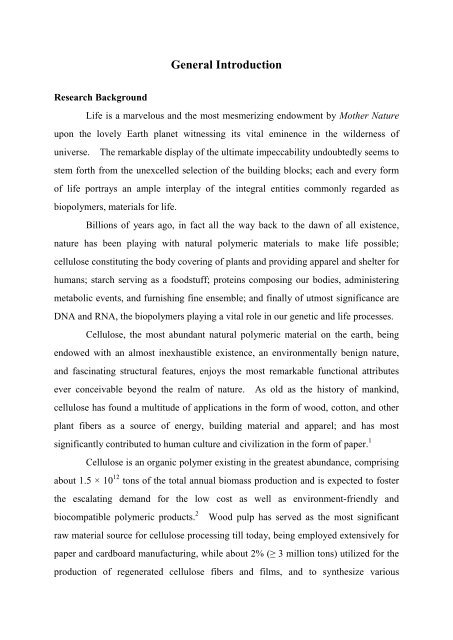Synthesis, Characterization, and Gas Permeation Properties
Synthesis, Characterization, and Gas Permeation Properties
Synthesis, Characterization, and Gas Permeation Properties
Create successful ePaper yourself
Turn your PDF publications into a flip-book with our unique Google optimized e-Paper software.
Research Background<br />
General Introduction<br />
Life is a marvelous <strong>and</strong> the most mesmerizing endowment by Mother Nature<br />
upon the lovely Earth planet witnessing its vital eminence in the wilderness of<br />
universe. The remarkable display of the ultimate impeccability undoubtedly seems to<br />
stem forth from the unexcelled selection of the building blocks; each <strong>and</strong> every form<br />
of life portrays an ample interplay of the integral entities commonly regarded as<br />
biopolymers, materials for life.<br />
Billions of years ago, in fact all the way back to the dawn of all existence,<br />
nature has been playing with natural polymeric materials to make life possible;<br />
cellulose constituting the body covering of plants <strong>and</strong> providing apparel <strong>and</strong> shelter for<br />
humans; starch serving as a foodstuff; proteins composing our bodies, administering<br />
metabolic events, <strong>and</strong> furnishing fine ensemble; <strong>and</strong> finally of utmost significance are<br />
DNA <strong>and</strong> RNA, the biopolymers playing a vital role in our genetic <strong>and</strong> life processes.<br />
Cellulose, the most abundant natural polymeric material on the earth, being<br />
endowed with an almost inexhaustible existence, an environmentally benign nature,<br />
<strong>and</strong> fascinating structural features, enjoys the most remarkable functional attributes<br />
ever conceivable beyond the realm of nature. As old as the history of mankind,<br />
cellulose has found a multitude of applications in the form of wood, cotton, <strong>and</strong> other<br />
plant fibers as a source of energy, building material <strong>and</strong> apparel; <strong>and</strong> has most<br />
significantly contributed to human culture <strong>and</strong> civilization in the form of paper. 1<br />
Cellulose is an organic polymer existing in the greatest abundance, comprising<br />
about 1.5 × 10 12 tons of the total annual biomass production <strong>and</strong> is expected to foster<br />
the escalating dem<strong>and</strong> for the low cost as well as environment-friendly <strong>and</strong><br />
biocompatible polymeric products. 2 Wood pulp has served as the most significant<br />
raw material source for cellulose processing till today, being employed extensively for<br />
paper <strong>and</strong> cardboard manufacturing, while about 2% (≥ 3 million tons) utilized for the<br />
production of regenerated cellulose fibers <strong>and</strong> films, <strong>and</strong> to synthesize various

















